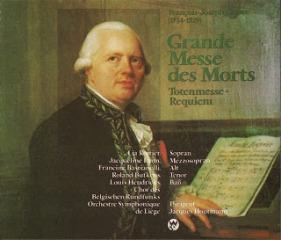Gossec – Grande Messe des Morts (Houtmann) [1982]
Gossec – Grande Messe des Morts (Houtmann) [1982]

1. Introduzione 4:50 Introitus 2. Requiem Aeternam 3:40 3. Te Decet Hymnus 3:45 4. Exaudi Orationem Meam 5:50 5. Requiem Aeternam 1:10 6. Et Lux Perpetua 5:30 Sequenz 7. Dies Irae 4:20 8. Tuba Mirum 4:10 9. Mors Stupebit 3:35 10. Quid Sum Miser 2:00 11. Recordare Jesu Pie 4:25 12. Inter Oves 7:00 13. Confutatis 4:00 14. Oro Supplex 1:05 15. Lacrimosa Dies Illa 4:10 16. Juidcandus 1:20 17. Pie Jesu Domine 5:10 Offertorium 18. Vado Et Non Revertar 5:00 19. Spera In Deo 5:05 20. Cedant Hostes 5:00 21. Sanctus 0:30 22. Pie Jesu Domine (Wandlungsmotette) 5:20 23. Agnus Dei 2:25 Communion 24. Lux Aeterna 4:30 25. Requiem Aeternam 5:30 Symphonie a 17 parties 26. I.Maestoso - Allegro molto 6:18 27. II.Larghetto 7:01 28. III.Minuetto 9:23 29. IV.Allegro assai 4:45 Lia Rottier - soprano Jacqueline Lamy - mezzo-soprano Francine Bastianelli - contralto Roland Bufkens - tenor Louis Hendrix - bass Choeurs de la RTB Orchestre Symphonique de Liège Jacques Houtmann – conductor
Though little known today, François-Joseph Gossec (1734-1829) was a composer of considerable significance, despite the fact that his contributions to the development of symphonic music in France were overshadowed by the material he provided for military and revolutionary purposes. Gossec’s 1760 Requiem (Missa pro defunctis) also served the purposes of revolution, in that performances given during August 1789 were dedicated to Parisian subjects who lost their lives during the storming of the Bastille. Mozart, incidentally, made Gossec’s acquaintance when staying in Paris in 1778, and described him (somewhat uncharitably) as “ein sehr trockner Mann” (“a very dull man”). That assessment notwithstanding, Gossec’s Requiem, with its surprising militaristic effects and pronounced theatricality, exerted tremendous influence upon the liturgical music of Berlioz. The other work here, a “Symphonie” in 17 parts, was written in 1809. Though of considerably less stature, this agreeably tuneful work still deserves an occasional hearing. -- classicstoday.com
It is not surprising that after the premiere of Messe des Morts in May 1760 the composer, François-Joseph Gossec, became an overnight success. It is surprising that, even today, a work of such magnificence remains relatively unknown. As few as five versions are to be found in the recorded music catalogue One may suggest as "amazing" the fact that in Vienna, the musical heart of Europe around 1800, where Haydn, Mozart, Beethoven and Schubert lived, this masterpiece by Gossec was not performed before 1992 and then only 18 of the total 25 movements.
Joseph Gossec was born in Belgium and later moved to Paris. Along with Sammartini, Haydn and composers of the Mannheim school he was the father of the classical symphony. Initially a choirboy, Gossec later became the protégé of his teacher Rameau.
Gossec wrote some fifty symphonies, and concertante works that attracted attention and invitations beyond France. The "hunting" symphonies of Karl Stamitz and Haydn are considered exact quotes from Gossec’s Symphonie de Chasse. Mozart’s Symphony in D major, written from Paris, unmistakably reflects Gossec’s influence and not least Beethoven’s Seventh Symphony contains similarities to Gossec’s Le Temple de la Révolution which some suggest to be plagiarism. As official composer for the French Revolution he wrote numerous choruses, marches, and hymns, a Te Deum and the opera, L’Offrande à la Liberté for public celebration.
Even before the publication of Haydn’s symphonies, in 1756 Gossec had his own first six symphonies published. However the 25 year-old composer intended his "breakthrough" by a masterpiece of breath-taking proportions. It is unknown for what occasion he composed his 90 minute long Requiem (Messe des Morts) but it is likely that Louis-Joseph de Bourbon commissioned a funeral mass for his daughter Marie who passed away one year, before aged three, and his wife who died on March 9th 1760, aged 23. It is a strange parallel to Count Wallseg-Schuppach who commissioned a Requiem from Mozart in similar circumstances but in that case the composer died before its completion.
Gossec divided the Latin requiem into twenty-five movements. He omitted the Kyrie and some strophes of the sequence. --- Zane Turner, www.musicweb-international.com
download (mp3 @320 kbs):
yandex 4shared mega mediafire cloudmailru uplea








